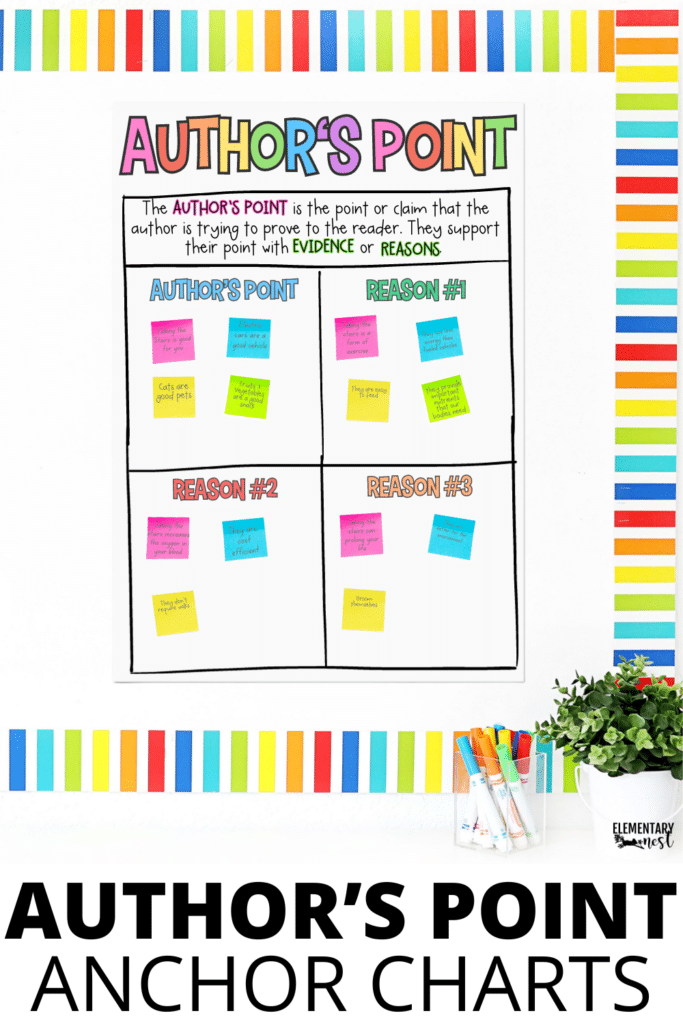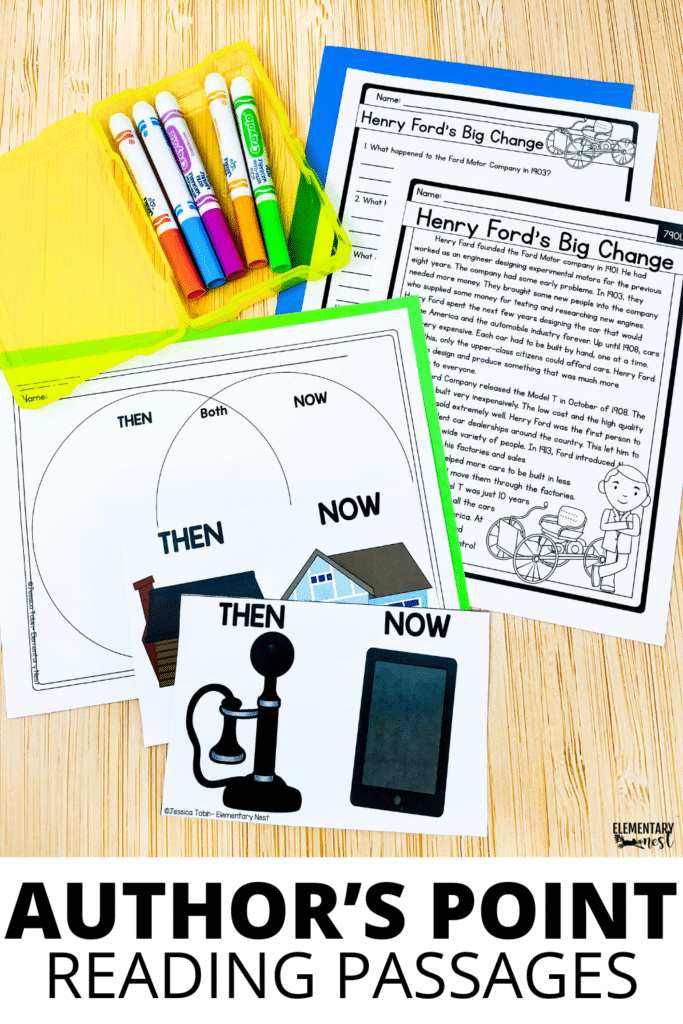
Hello teachers!! Today, I am going to be talking about teaching author’s point and reasons. This skill is only found in the Informational ELA standards but will transfer across literacy skills. When teaching author’s point and reasons, you are going to want to scaffold your instruction to build your student’s understanding.
Author’s Point Standards:
- Kinder: With prompting and support, identify the reasons an author gives to support points in a text. (CCSS.ELA-LITERACY.RI.K.8)
- 1st Grade: Identify the reasons an author gives to support points in a text. (CCSS.ELA-LITERACY.RI.1.8)
- 2nd Grade: Describe how reasons support specific points the author makes in a text. (CCSS.ELA-LITERACY.RI.2.8)
- 3rd Grade: CCSS didn’t give a specific standard for this reading skill in 3rd grade, so 3rd grade teachers can pull from 2nd or 4th grade standards/content when teaching!
- 4th Grade: Explain how an author uses reasons and evidence to support particular points in a text. (CCSS.ELA-LITERACY.RI.4.8)
What is an author’s point?


Unlike point of view where you are focused on the narrator, the author’s point is directly connected to the writer of the text. So, you are going to want to spend some time working with this concept. You want your students to understand that the author’s point is what the author, or writer, is trying to prove to you, the reader.

The author’s point is usually something that they believe or feel. So, in order to prove that point, they will supply the reader with information about the point. Sometimes, the author’s point is stated somewhere in the text, but not always. Students will need to figure out exactly “what” the author is trying to prove.
Teaching Students to Find an Author’s Point

As I previously mentioned, when teaching author’s point and reasons it is a good idea to scaffold your instruction. Using images can be a great lead into identifying author’s point. With images, students can see the clues and evidence to figure out how the author feels or what the author believes about the subject. For example, if a student is looking at the photograph of the plants and plastic bottles, they may be able to see that the “author” (the photographer) believes that recycling is important.
They can see clues from the surrounding green plants, shining sun, and the collection of plastic items that are likely being recycled. Although it is not written across the picture, it is still a clear message.

Once students have practiced interpreting author’s points in images, they can move onto the next component: Author’s reasons. When reading texts, students will be able to discover an author’s point with the reasons they use in the text. Because many author’s points are subjective, they will need strong evidence and reasoning to support their point. So, the evidence will likely be factual information about the topic.
I like to start with point and reason matching activities. Students will use cards to match reasons with author’s points that make the most sense. This allows students to build their skill before moving onto full texts. They can also practice with supplying their own reasons for specific points and topics!
Supporting the Author’s Point with Reasons

Now, it is time to break out the texts! Students will be able to use their skills to locate evidence within texts that supports the author’s claim or point! A great way to do this is to use highlighting or underlining. You can provide students will prompted tasks/cards or have students work with partners to locate and mark the evidence.
Great Texts for Author’s Point

As with all ELA skills, using mentor texts to model the thinking strategies can increase student mastery. Find a time for short, informational text read alouds that allow you to show students what types of questions and prompts they should be thinking when reading a nonfiction text. When you are teaching author’s point and reasons incorporate think alouds, like: “What is the author trying to prove?” “The author just stated…..which makes me think they believe that…” Etc.
Some great read-aloud options include:
- If You Lived in Colonial Times by Ann Mcgovern
- What If Everyone Did That? by Ellen Javernick
- Hippos are Huge! by Jonathan London
- The Bravest Dog Ever: The Story of Balto by Natalie Standiford
- What If You Had Animal Teeth? by Sandra Markle
- Tuesday Tucks Me In by Luis Carlos Montalvan

It’s also important to use short passages as text activities because students need to practice this format of reading comprehension. When using informational text passages like the one above, students can be guided to look for the right kind of information. This will help build their reading muscle memory, allowing them to transfer the skill to books and other reading formats. *Be sure to include a mix of both passages and authentic texts.*
More Author’s Point Activities for Practice and Mastery

Graphic organizers are another way to guide students’ thinking. They can be easily added to a small group or center activity! These graphic organizers are designed to be used with any nonfiction text/passage, which will make them a great activity for independent readers are partner work, too!

Don’t forget that it is important to keep students engaged with different formats of skill practice. So, try incorporating interactive notebook prompts and task cards that will continue student skill mastery!
Need Author’s Point resources?
Check out these full units for 1st, 2nd, and 4th grade. Many of the activities in these packs overlap for each grade level but have higher written text levels for any passages. When purchasing for your grade level, make sure to buy only the grade level you need.




These units are complete and will help you teach author’s points and reasons within nonfiction texts. They come with anchor charts, lesson plans and activities, graphic organizers, reading passages, task cards, interactive notebooks, assessments, and more!
Want more ELA teaching ideas? Check out these blog posts:
Want a FREE context clue activity set?

3 free Context Clues Activities sent directly to your inbox!
Simply choose your grade level:


















